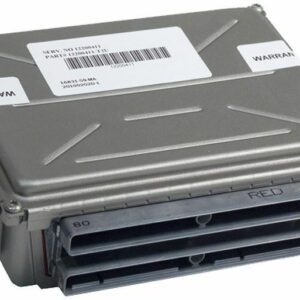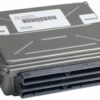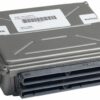Restore Your Truck’s Performance with a Reliable Powertrain Control Module
Is your 2005-2007 Silverado 2500 acting up? If you’re dealing with a persistent check engine light, rough idling, stalling, or poor fuel economy, the problem might be the very brain of your engine: the Powertrain Control Module (PCM). As a technician with over two decades of experience under the hood, I’ve seen firsthand how a failing PCM can cause frustrating, hard-to-diagnose issues. This isn’t just a part; it’s the central command center that manages everything from fuel injection and ignition timing to transmission shifting. A faulty one can leave your powerful truck feeling weak and unreliable.
This isn’t a generic, off-the-shelf module. We provide a direct-fit solution for your vehicle. The biggest headache with replacing a PCM is the required programming—a step that usually means a costly trip to the dealership. We eliminate that completely. When you purchase this module, you simply provide us with your vehicle’s VIN. Our experts then flash the PCM with the latest, most stable GM-approved software specific to your truck. It arrives at your door ready for a straightforward installation, saving you time, money, and the hassle of coordinating with a dealer service center. This is the most efficient way to get your Silverado back to factory-spec operation.
From the Diagnostic Bay: The Ghost in the Machine
I remember a 2006 Silverado 2500 with the 8.1L that came into my shop with a complaint of intermittent stalling and a flashing check engine light. The owner had already replaced the spark plugs, ignition coils, and even the mass airflow sensor, but the problem persisted. The codes were all over the place—random misfires, O2 sensor faults, and a dreaded U0100 (Lost Communication with ECM/PCM). After verifying the power and ground circuits to the PCM were solid (always the first step!), we connected a scope and saw the module’s internal voltage regulation was erratic. A new, properly programmed PCM fixed everything instantly. It’s a classic case where chasing symptoms costs more than diagnosing the root cause—the failing computer itself.
Common Signs of a Failing PCM
- ✔ Persistent Check Engine Light (CEL) that won’t clear.
- ✔ Engine cranks but refuses to start.
- ✔ Unexplained stalling or rough, erratic idling.
- ✔ Noticeable decrease in fuel efficiency.
- ✔ Harsh or incorrect automatic transmission shifting.
- ✔ Diagnostic trouble codes (DTCs) pointing to internal module failure, such as P0601, P0602, or P0606.
- ✔ Communication errors with scan tools (U-codes).
A Straightforward Guide to Installation
- ✔ Safety First: Disconnect the negative terminal from your vehicle’s battery and secure it away from the post to prevent accidental reconnection.
- ✔ Locate the PCM: On most 2005-2007 Silverado and Sierra trucks, the PCM is located in the engine bay on the driver’s side, typically under or next to the battery tray. You may need to remove the battery to gain access.
- ✔ Disconnect the Connectors: Carefully unlatch and remove the electrical wiring harness connectors from the old PCM. These connectors have locking tabs; be gentle to avoid breaking them.
- ✔ Remove the Old Module: Unbolt the PCM from its mounting bracket. Keep the hardware, as you may need to reuse it.
- ✔ Install the New Module: Mount your new, pre-programmed PCM onto the bracket and secure it.
- ✔ Reconnect Everything: Firmly plug the wiring harness connectors into the new module until they click into place. Reinstall and reconnect the battery, starting with the positive terminal, then the negative.
- ✔ Final Steps: Start the engine. The vehicle may need to complete a drive cycle for all systems to recalibrate. In some cases, a security or CASE (Crankshaft Angle Sensor Error) relearn procedure may be necessary, which can be performed with many professional-grade scan tools.
Will This Fit My Vehicle?
This module is a direct replacement for part numbers 12589462, 12602801, and 89017749. It is guaranteed to fit the following makes and models with the specified options. Please verify your vehicle is on this list before ordering.
AVALANCHE 2500 05-06 (LH front under battery)
BLAZER S10/JIMMY S15 05 (RH front engine compartment)
CTS 04-05 V-Series (ID 12589462 or 12602801)
EXPRESS/SAVANA 1500 VAN 05-07 (LH rear engine compartment)
EXPRESS/SAVANA 2500 VAN 05-07 Gasoline (LH rear engine compartment)
EXPRESS/SAVANA 3500 VAN 05-07 Gasoline (LH rear engine compartment)
SAFARI (GMC) 05 (LH front by battery)
SIERRA/SILVERADO 1500 PICKUP 05-07 Classic Style, 4.3L, w/o hybrid (LH front under battery)
SIERRA/SILVERADO 2500 PICKUP 05-07 Classic Style, 8.1L Gasoline (LH front under battery)
SIERRA/SILVERADO 3500 PICKUP 05-07 Classic Style, 8.1L Gasoline (LH front under battery)
SUBURBAN 2500 05-06 8.1L (LH front under battery)
YUKON XL 2500 05-06 8.1L (LH front under battery)
Frequently Asked Questions
Frequently Asked Questions
Why do you need my VIN?
Your Vehicle Identification Number (VIN) allows us to program the PCM with the exact software and calibrations your truck was built with. This ensures perfect compatibility with your engine, transmission, and other factory options, making the installation plug-and-play.
Is this a simple DIY job?
For someone with basic mechanical skills and tools, this is a very manageable job. The most important parts are safely disconnecting the battery and being careful with the plastic electrical connectors. Since we handle the programming, you avoid the most complex part of the process.
Will this fix my specific problem?
This module will resolve issues directly caused by a faulty PCM. While the symptoms listed are common indicators, we always recommend a proper diagnosis to confirm the PCM is the point of failure before ordering. Check for solid power, grounds, and sensor inputs first.
What if I have a different part number?
This module is a direct replacement for part numbers 12589462, 12602801, and 89017749. If your original module has one of these numbers, this part is compatible.
Is any other learning procedure required after installation?
No further programming is needed. However, after installation, your vehicle may require a security relearn or a CASE relearn procedure. This is standard and can often be initiated with a capable bidirectional scan tool or sometimes by following a specific drive cycle.



